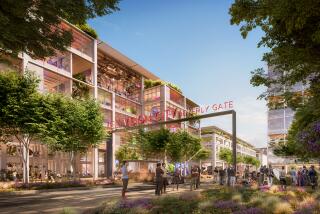Property Owner Fights Downey Redevelopment : Suit Alleges That Woodruff Project Area Is Not Blighted, Seeks to Void Plan
- Share via
DOWNEY — A property owner in the city’s newly created industrial redevelopment district has sued Downey, seeking to invalidate the revitalization plan.
Lois Du Lac of Hesperia filed the suit in Los Angeles Superior Court earlier this month. Du Lac and her husband, Leo, own a cluster of small buildings on a two-acre parcel in the redevelopment district, known as the Woodruff Industrial Project.
The lawsuit alleges that the City Council should not have approved the redevelopment district in July because the area is not “blighted.” Under state law, an area must be blighted before a redevelopment zone can be established.
The suit names as defendants the City of Downey, the Downey Community Development Commission, Los Angeles County and county Auditor-Controller Mark Bloodgood. The City Council doubles as the Community Development Commission, which considers development issues.
The redevelopment district encompasses 118 acres straddling Woodruff Avenue south of Firestone Boulevard on Downey’s east side.
“The project areas are predominantly either already economically prosperous, in the seminal stages of new developments, newly developed or vacant land susceptible (to) development without the intervention of redevelopment,” the lawsuit said.
The lawsuit also claims that the city has incorrectly estimated how much revenue will be generated by the redevelopment district. It claims that revenue will fall drastically short of the $100 million the redevelopment agency expects to spend on public improvements, development incentives and other expenses during the 30-year life of the plan.
“(The suit) is kind of silly,” said Jim Cutts, city director of community development. “There is a need to rectify some of the problems in existence over there.”
The city contends that the Woodruff area is blighted, with some dilapidated buildings and land uses that do not conform to current zoning. It also contends that not enough water is going into some parts of the area to fight fires and that the economic benefits of a redevelopment zone are needed to encourage growth.
Cutts said the city expects to receive $25.8 million in additional tax revenue during the life of the district. He said other sources of revenue, such as state and federal grants, will be needed if the agency is to spend $100 million on the district. If such grants cannot be obtained, the city’s outlay on the project may have to be reduced, he said.
The City Council approved the district July 20 after extensive negotiations with owners who feared that they would be forced to sell their property or relocate their businesses to make way for large redevelopment projects.
In most projects, the redevelopment agency is given the power of eminent domain. But the City Council bowed to public pressure, and redevelopment officials were left lamenting the loss of a powerful redevelopment tool.
Longtime Tenants
The Du Lac buildings are occupied by a sign shop, a number of machine shops and other small businesses. The Du Lacs said some tenants have occupied the buildings for 30 years and others have passed on their businesses to a second generation.
Last April, the Du Lacs and their tenants submitted a petition requesting that their property be excluded from the redevelopment plan because they feared eminent domain. Some of the tenants told The Times that they faced the loss of their businesses because they would be unable to afford higher rents if they were forced to move.
“We’re very happy the way things have been,” Du Lac said at the time.
The lawsuit claims that Du Lac will be “irreparably injured” by the redevelopment plan.
Du Lac declined to comment when asked how a plan that lacks the power of eminent domain could jeopardize her interests or whether she fears that the plan will be amended to give the redevelopment agency condemnation powers.
Damages Sought
In addition to its call to invalidate the plan, the lawsuit seeks an unspecified award for general damages and attorney’s fees. The lawsuit named the county and Bloodgood as defendants to prevent them from paying Downey new property tax revenue generated by the redevelopment district.
The Du Lac suit is the latest obstacle to Downey’s redevelopment effort, which began in 1978 when the city established its first and only other redevelopment district, a 125-acre zone running along Firestone Boulevard, Downey’s main commercial sector.
The City Council expanded that district by more than 380 acres in 1984, but a judge invalidated the plan after finding that Councilman James S. Santangelo had a conflict of interest when he cast the deciding vote. Santangelo owned property in both the original and the expanded redevelopment areas.
The city appealed to the 2nd District Court of Appeal and is awaiting a decision. The redevelopment agency would have had condemnation powers in the expanded area, as it does in the original zone.
In the meantime, Downey moved forward with an alternative expansion plan in case the appeal is unsuccessful. In July, the city added 305 acres to the original redevelopment district but did not give condemnation powers to the redevelopment agency.
More to Read
Sign up for Essential California
The most important California stories and recommendations in your inbox every morning.
You may occasionally receive promotional content from the Los Angeles Times.










